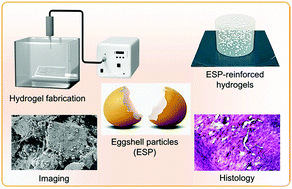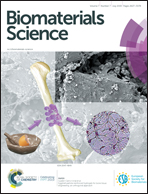Eggshell particle-reinforced hydrogels for bone tissue engineering: an orthogonal approach
Abstract
Hydrogel-based biomimetic scaffolds have generated broad interest due to their tunable physical, chemical, and biological properties for bone tissue engineering applications. We fabricated eggshell microparticle (ESP) reinforced gelatin-based hydrogels to obtain mechanically stable and biologically active three-dimensional (3D) constructs that can differentiate pre-mature cells into osteoblasts. Physical properties including swelling ratio, degradation, and mechanical properties of the composite hydrogels were investigated. Pre-osteoblasts were encapsulated within the ESP-reinforced hydrogels to study their differentiation and evaluate mineral deposition by these cells. The ESP-reinforced gels were then subcutaneously implanted in a rat model to determine their biocompatibility and degradation behaviors. The composite hydrogels have shown outstanding tunability in physical and biological properties holding substantial promise for engineering mineralized tissues (e.g. bone, cartilage, tooth, and tendon). These 3D scaffolds enabled the differentiation of pre-osteoblasts without the use of specialized osteogenic growth medium. The ESP-reinforced gels exhibited significant enhancement in mineralization by pre-osteoblasts. These behaviors are positively correlated with increasing concentrations of ESP. Findings suggest that our novel composite hydrogel exhibits superior mechanical properties and indicates a favorable in vivo response by subcutaneous implantation in a rat model.



 Please wait while we load your content...
Please wait while we load your content...